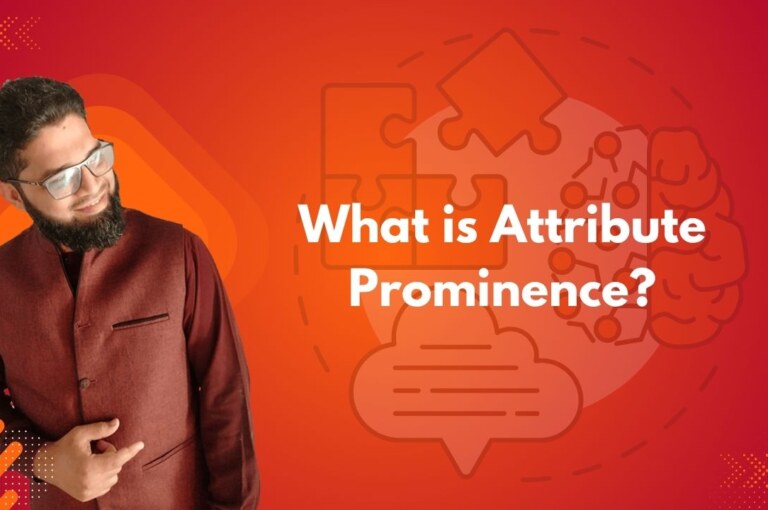Attribute prominence refers to the level of emphasis or visibility given to key elements on a webpage. These elements are the structural and content-related components that signal importance to both users and search engines. When used strategically, prominent attributes make your page more discoverable, easier to navigate, and more effective in communicating your message.
When used strategically, prominent attributes make your page more discoverable, easier to navigate, and more effective in communicating your message. This principle works in tandem with contextual layers, content configuration, and user experience signals to boost engagement and SEO impact.
Common prominent attributes include:
- Headings and Subheadings
- Keywords and their placement
- Meta Title and Description
- Internal and External Links
- Images and Visual Content
Structuring content to highlight these attributes helps convey topical relevance and intent more clearly. It also enhances readability, accessibility, and discoverability.
Why Attribute Prominence Matters!
Understanding why attribute prominence matters is key to creating content that not only ranks well but also keeps users engaged from the moment they land on your page.
1. Boosts SEO Rankings
Search engines rely heavily on visible and structured content elements when determining a page’s ranking. By placing keywords in strategic spots (e.g., titles, H1 tags, meta descriptions), you send strong topical signals that improve search relevance.
2. Enhances User Experience
Users scan webpages. Prominent headings, well-placed links, and visually clear formatting make it easier for users to quickly locate the information they need, reducing bounce rates and increasing engagement.
3. Increases Click-Through Rates (CTR)
A compelling meta title and clear headings can make your content more attractive in search engine result pages (SERPs). Users are more likely to click when they instantly see relevance and value.
4. Strengthens Content Organization
Attribute prominence ensures your content is cleanly structured and easy to follow. It helps segment large blocks of text, improving flow and helping both readers and crawlers understand content hierarchy.
You improve clarity, boost SEO performance, and deliver a smoother, more valuable user experience, by making your most important content elements prominent,
Key Elements of Attribute Prominence
To make your content more effective, it’s crucial to highlight elements that both users and search engines prioritize. These key components ensure your page stands out and performs well.
1. Headings (H1, H2, H3…)
Headings are some of the most visually and semantically prominent elements on a webpage. They guide users through your content while helping search engines understand its structure.
Example:
H1: “The Ultimate Guide to Healthy Eating”
H2: “Top Foods for a Balanced Diet”
H2: “How to Plan Your Meals”
Tip: Use a clear H1 once per page, and cascade subtopics using H2, H3, etc., to maintain hierarchy.
2. Keyword Placement and Density
Keywords placed in the title, headings, and early paragraphs carry more weight. This doesn’t mean stuffing — just strategic placement.
Example:
For a post on “digital marketing strategies,” place the phrase in the:
- Page title
- Meta title
- H1 tag
- Opening paragraph
- A few subheadings
Best Practice: Use LSI (Latent Semantic Indexing) terms naturally to support the main keyword and avoid repetition.
3. Meta Tags (Title and Description)
Meta tags are often the first impression a user has with your content. They appear in search engine listings and play a critical role in CTR and SEO.
Example:
- Meta Title: “Top SEO Practices for 2025 | Rank Higher in Google”
- Meta Description: “Explore essential SEO techniques for better visibility and traffic in 2025. Learn what matters now.”
Tip: Keep meta titles under 60 characters and descriptions under 160 for best SERP display.
4. Internal and External Links
Strategically placed links direct users to relevant content, improving site structure and credibility.
- Internal links enhance user engagement and SEO crawlability.
- External links lend authority and provide supportive information.
Example:
In a blog post on “Email Marketing Tips,” link to another internal page on “How to Build an Email List” and an external source like Mailchimp’s guide to campaigns.
5. Images and Visual Cues
Images break up text and reinforce meaning. Properly labeled images (with descriptive alt text) not only help visually impaired users but also give search engines context about the content.
Example:
Alt Text: “Modern kitchen remodel after renovation with smart appliances”
Tip: Use high-resolution images, add captions, and maintain mobile responsiveness.
How to Use Attribute Prominence Effectively!
Understanding how to use attribute prominence effectively can significantly improve both user engagement and search engine visibility. It’s about placing the right elements in the right places to guide attention naturally.
| Strategy | Purpose |
|---|---|
| Focus on Key Areas | Optimize headings, meta tags, and keyword positioning. |
| Maintain Balance | Avoid keyword stuffing or over-formatting. |
| Improve Readability | Use bullet points, short paragraphs, and clear headings. |
| Optimize Metadata | Ensure titles and descriptions are clear, relevant, and action-oriented. |
| Add Useful Links | Connect users to helpful internal and external content naturally. |
Example: Attribute Prominence in Action
Imagine you’re writing a blog on “Home Office Setup.” Here’s how you apply attribute prominence:
- H1: The Complete Guide to Setting Up a Home Office
- Meta Title: Best Home Office Setup Ideas for Productivity
- Meta Description: Explore layout tips, desk accessories, and productivity hacks to create the perfect home office.
- Internal Links: Link to articles on “Ergonomic Chairs” and “Top Productivity Apps.”
- Images: Add images of minimalist home setups with proper alt text.
Common Mistakes to Avoid
- Repeating the same keyword excessively
- Using multiple H1 tags
- Overloading content with visual clutter
- Generic meta descriptions that don’t match page intent
- Broken or unrelated links
Wrap Up
Attribute prominence plays a vital role in how both users and search engines interpret your content. By emphasizing headings, keywords, meta data, internal links, and visual elements, you can craft pages that are not only SEO-friendly but also user-focused.
Prioritize visibility where it matters most—because what stands out gets found.
Want to Go Deeper into SEO?
Explore more from my SEO knowledge base:
▪️ SEO & Content Marketing Hub — Learn how content builds authority and visibility
▪️ Search Engine Semantics Hub — A resource on entities, meaning, and search intent
▪️ Join My SEO Academy — Step-by-step guidance for beginners to advanced learners
Whether you’re learning, growing, or scaling, you’ll find everything you need to build real SEO skills.
Feeling stuck with your SEO strategy?
If you’re unclear on next steps, I’m offering a free one-on-one audit session to help and let’s get you moving forward.





Leave a comment